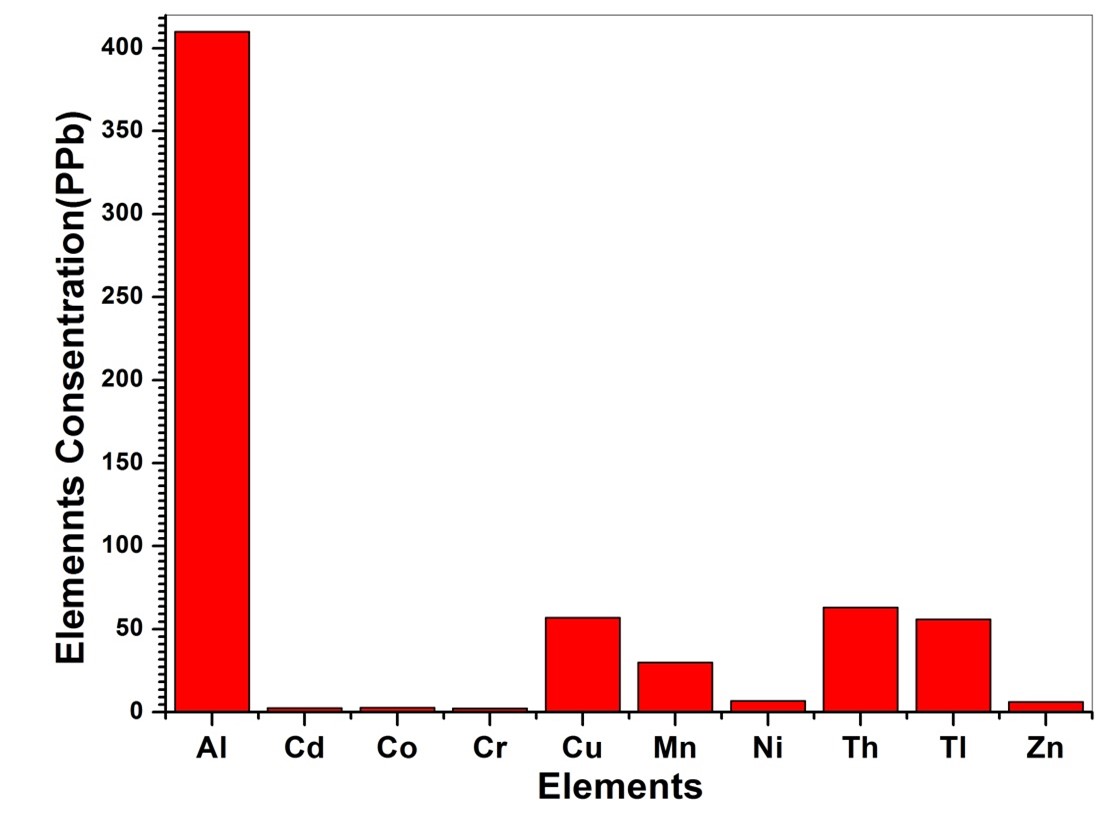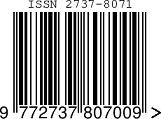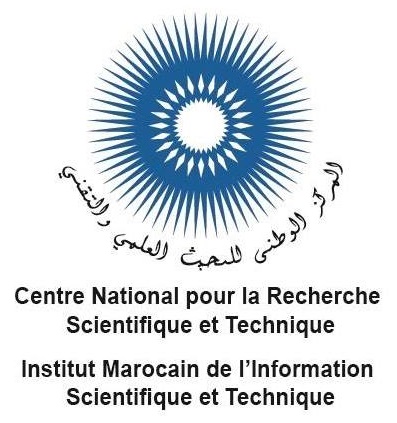Study of Environmental Pollution Rustling from Balhaf Liquid Natural Gas Station Using Spectroscopy Analysis, Shabwah Governorate – Yemen
Keywords:
LNG Project, LIBS, ICP, pollution, Shabowah, Balhaf, Yemen, FTIRAbstract
The present work aimed to determine the contaminants in soil resulting due to emissions that come from natural gas in the station of Balhaf which is it LNG project in Shabowah Gov, Republic of Yemen. Total 20 samples soil samples were collected at depth of approximately (0-10 cm) from different locations from the Balhaf natural gas station. These samples were analyzed by Laser Breakdown Plasma Spectroscopy (LIBS) to determine the samples toxic elements. The components of the toxic elements present in the soil samples were further confirmed by spectroscopic technique induced coupled plasma (ICP) and Fourier Transform Infrared spectroscopy (FTIR) techniques. The LIBS spectra showed the presence of different amounts of elements, including radioactive and toxic elements such as (Ac, Pu, Th, U) and (Al, Ba, Cd, Co, Cr, Cu, Hg, Mn, Ni, Pb, Tl, Zn), in all of the soil samples. The concentrations of the elements were calculated by ICP spectroscopy. The average concentrations of elements in the samples appeared to be 410 ppb for Al, 1.9 ppb for Ba, 2.6 ppb for Cd,2.7 ppb for Co, 2.3 ppb for Cr, 257 ppb for Cu, 30 ppb for Mn, 6,8 ppb for Ni, 63 ppb for Th, 56 ppb for Tl and 6.1 ppb for Zn, but these values did not exceed normal levels for these elements in earth crust according to reference values such as ATSDR 2020, IAEA, 200. The presence of a high concentration of toxic elements in the soil around the natural gas facility, that indicates the presence of emissions from this facility that leads to the accumulation of these elements in the soil.
Downloads
References
M. K. Hill, Understanding environmental pollution. Cambridge University Press, 2020.
J. J. Peirce, P. A. Vesilind, and R. Weiner, Environmental pollution and control. Butterworth-Heinemann, 1998.
I. L. Pepper, C. P. Gerba, and M. L. Brusseau, Environmental and pollution science. Elsevier, 2011.
C. Su, “A review on heavy metal contamination in the soil worldwide: Situation, impact and remediation techniques,” Environ. Skept. Critics, vol. 3, no. 2, p. 24, 2014.
C. A. T. Force, “Fossil Fumes: A Public Health Analysis of Toxic Air Pollution From the Oil and Gas Industry (June 2016).” .
L. M. McKenzie, R. Z. Witter, L. S. Newman, and J. L. Adgate, “Human health risk assessment of air emissions from development of unconventional natural gas resources,” Sci. Total Environ., vol. 424, pp. 79–87, 2012.
L. B. Paulik et al., “Impact of natural gas extraction on PAH levels in ambient air,” Environ. Sci. Technol., vol. 49, no. 8, pp. 5203–5210, 2015.
T. Colborn, C. Kwiatkowski, K. Schultz, and M. Bachran, “Natural gas operations from a public health perspective,” Hum. Ecol. risk Assess. An Int. J., vol. 17, no. 5, pp. 1039–1056, 2011.
F. Perera, “Pollution from fossil-fuel combustion is the leading environmental threat to global pediatric health and equity: Solutions exist,” Int. J. Environ. Res. Public Health, vol. 15, no. 1, p. 16, 2018.
N. Fann et al., “Assessing human health PM2. 5 and ozone impacts from US oil and natural gas sector emissions in 2025,” Environ. Sci. Technol., vol. 52, no. 15, pp. 8095–8103, 2018.
A. P. Pacsi, Y. Kimura, G. McGaughey, E. C. McDonald-Buller, and D. T. Allen, “Regional ozone impacts of increased natural gas use in the Texas power sector and development in the Eagle Ford shale,” Environ. Sci. Technol., vol. 49, no. 6, pp. 3966–3973, 2015.
C.-H. Chaîneau et al., “Results and lessons learned from a 3-year intensive coral communities monitoring during the construction of a LNG plant in Yemen,” 2010.
“FACTBOX - Five facts about,” vol. 15, p. 2010, 2010.
W. R. True, “Yemen LNG yields first production into glutted market,” pp. 7–8, 2009.
W. L. Lindsay, Chemical equilibria in soils. John Wiley and Sons Ltd., 1979.
G. H. Ong, C. K. Yap, M. Mahmood, S. G. Tan, and S. Hamzah, “Barium levels in soils and Centella asiatica,” Trop. life Sci. Res., vol. 24, no. 1, p. 55, 2013.
A. M. Evans, W. L. Barrett, T. Bell, J. Milsom, C. J. Moon, and B. C. Scott, “Introduction to mineral exploration.” Blackwell, London, 1993.
C. J. Moon, K. G. Whateley, and A. M. Evans, “Introduction to Mineral Exploration BLACKWELL PUBLISHING,” New York, 2006.
H. E. Hawkes and J. S. Webb, Geochemistry in mineral exploration. Harper & Row, 1965.
J. E. Sansonetti and W. C. Martin, “Handbook of basic atomic spectroscopic data,” J. Phys. Chem. Ref. Data, vol. 34, no. 4, pp. 1559–2259, 2005, doi: 10.1063/1.1800011.
W. H. O. WHO, “Mercury in Drinking-water, Background document for development of WHO Guidelines for Drinking-water Quality,” Who, vol. WHO/SDE/WS, p. WHO/SDE/WSH/05.08/10, 2005, [Online]. Available: http://www.who.int/water_sanitation_health/dwq/chemicals/mercuryfinal.pdf.
G. Gauglitz and D. S. Moore, Handbook of spectroscopy, vol. 1. Wiley-Vch Weinheim, 2014.
C. E. Fonrobert, “The political symbolism of the Eruv,” Jew. Soc. Stud., vol. 11, no. 3, pp. 9–35, 2005.
D. Lin-Vien, N. B. Colthup, W. G. Fateley, and J. G. Grasselli, The handbook of infrared and Raman characteristic frequencies of organic molecules. Elsevier, 1991.
Y. S. Mary et al., “Vibrational spectroscopic studies and computational study of 4-fluoro-N-(2?-hydroxy-4?-nitrophenyl) phenylacetamide,” J. Mol. Struct., vol. 994, no. 1–3, pp. 223–231, 2011.
A. Anantharaman, S. Ramalakshmi, and M. George, “Green synthesis of calcium oxide nanoparticles and its applications,” Int. J. Eng. Res. Appl, vol. 6, no. 10, pp. 27–31, 2016.
B. H. Stuart, Infrared spectroscopy: fundamentals and applications. John Wiley & Sons, 2004.
L. J. Bellamy, “The Infrared Spectra of Complex Molecules 2$$^{rm nd} $$ ed,” London Chapmann Hall, 1980.
K. Fernández and E. Agosin, “Quantitative analysis of red wine tannins using Fourier-transform mid-infrared spectrometry,” J. Agric. Food Chem., vol. 55, no. 18, pp. 7294–7300, 2007.

Downloads
Published
How to Cite
Issue
Section
License
Copyright (c) 2022 Khaled Laqal, Siddig Tawaer Kafi, yousif alsabah, Abobakr A. M. Salem

This work is licensed under a Creative Commons Attribution 4.0 International License.
Copyright on any article in the International Journal of Engineering and Applied Physics is retained by the author(s) under the Creative Commons license, which permits unrestricted use, distribution, and reproduction provided the original work is properly cited.
License agreement
Authors grant IJEAP a license to publish the article and identify IJEAP as the original publisher.
Authors also grant any third party the right to use, distribute and reproduce the article in any medium, provided the original work is properly cited.
Most read articles by the same author(s)
- yousif alsabah, Abdelrahman A. Elbadawi, Rania M. Abaker, Abdelsakhi Suliman, Hassan H. Abuelhassan, Optical properties and efficiency studies for Beta Vulgarize, Curcuma Longa and Vulgaris var. cicla dye sensitized solar cell , International Journal of Engineering and Applied Physics: Vol. 2 No. 3: September 2022
- yousif alsabah, Suliman A. Abadalla, Abdelrahman A. Elbadawi, Hassan H. Abuelhassan, Assessment of wind energy potential in Nyala: South Darfur state, Sudan , International Journal of Engineering and Applied Physics: Vol. 4 No. 3: September 2024
- Reham Seddig Mohammed Ahmed, yousif alsabah, Ali A. S. Marouf , Electrochemical Performance of Laser Modified Zinc Electrode , International Journal of Engineering and Applied Physics: Vol. 2 No. 3: September 2022














